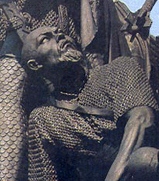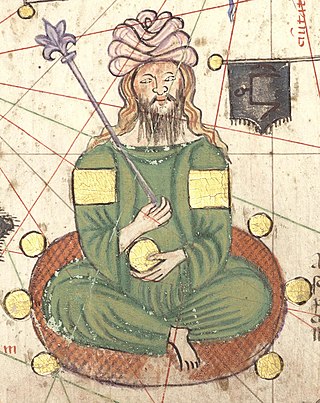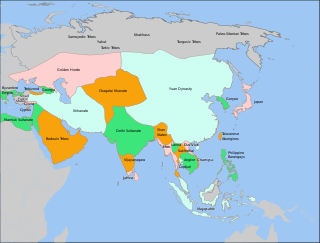
The Tatars, formerly also spelt Tartars, is an umbrella term for different Turkic ethnic groups bearing the name "Tatar" across Eastern Europe and Asia. Initially, the ethnonym Tatar possibly referred to the Tatar confederation. That confederation was eventually incorporated into the Mongol Empire when Genghis Khan conquered the various steppe tribes. Historically, the term Tatars was applied to anyone originating from the vast Northern and Central Asian landmass then known as Tartary, a term which was also conflated with the Mongol Empire itself. More recently, however, the term has come to refer more narrowly to related ethnic groups who refer to themselves as Tatars or who speak languages that are commonly referred to as Tatar.

The Golden Horde, self-designated as Ulug Ulus was originally a Mongol and later Turkicized khanate established in the 13th century and originating as the northwestern sector of the Mongol Empire. With the division of the Mongol Empire after 1259, it became a functionally separate khanate. It is also known as the Kipchak Khanate or as the Ulus of Jochi, and it replaced the earlier, less organized Cuman–Kipchak confederation.
Khan is a historic Mongolic and Turkic title originating among nomadic tribes in the Central and Eastern Eurasian Steppe to refer to king. It first appears among the Rouran and then the Göktürks as a variant of khagan and implied a subordinate ruler. In the Seljuk Empire, it was the highest noble title, ranking above malik (king) and emir (prince). In the Mongol Empire it signified the ruler of a horde (ulus), while the ruler of all the Mongols was the khagan or great khan. The title subsequently declined in importance. During the Safavid and qajar dynasty it was the title of an army general high noble rank who ruling a province, and in Mughal India it was a high noble rank restricted to courtiers. After the downfall of the Mughals it was used promiscuously and became a surname. Khan and its female forms occur in many personal names, generally without any nobiliary of political relevance, although it remains a common part of noble names as well.

Mamai was a powerful Mongol military commander of the Golden Horde. Contrary to popular misconception, he was not a khan (king), but was a kingmaker for several khans, and dominated parts or all of the Golden Horde for a period of almost two decades in the 1360s and 1370s. Although he was unable to stabilize central authority during the war of succession known as the Great Troubles, Mamai remained a remarkable and persistent leader for decades, while others came and went in rapid succession. His defeat in the Battle of Kulikovo marked the beginning of the decline of the Horde, as well as his own rapid downfall.
Nawab, also spelled Nawaab, Navaab, Navab, Nowab, Nabob, Nawaabshah, Nawabshah or Nobab, is a royal title indicating a sovereign ruler, often of a South Asian state, in many ways comparable to the western title of Prince. The relationship of a Nawab to the Emperor of India has been compared to that of the Kings of Saxony to the German Emperor. In earlier times the title was ratified and bestowed by the reigning Mughal emperor to semi-autonomous Muslim rulers of subdivisions or princely states in the Indian subcontinent loyal to the Mughal Empire, for example the Nawabs of Bengal.

Sultan Giyasuddin Muhammad Uzbek Khan, better known as Uzbeg, Uzbek or Ozbeg (1282–1341), was the longest-reigning khan of the Golden Horde (1313–1341), under whose rule the state reached its zenith. He was succeeded by his son Tini Beg. He was the son of Toghrilcha and grandson of Mengu-Timur, who had been khan of the Golden Horde from 1267 to 1280.

Sarai was the name of possibly two cities near the lower Volga, that served successively as the effective capitals of the Golden Horde, a Turco-Mongol kingdom which ruled much of Northwestern Asia and Eastern Europe, in the 13th and 14th centuries. There is considerable disagreement among scholars about the correspondence between specific archaeological sites and the various references to سرای, (Sarāy); سرای باتو ; سرای برکه, ; سرای الجدید, ; and سرای المحروسه in the historical sources.
Mirza is a name of Persian origin. It is used as a surname or prefix to identify patriarchal lineage.

Jani Beg, also known as Janibek Khan, was Khan of the Golden Horde from 1342 until his death in 1357. He succeeded his father Öz Beg Khan.

The Turco-Mongol or Turko-Mongol tradition was an ethnocultural synthesis that arose in Asia during the 14th century, among the ruling elites of the Golden Horde and the Chagatai Khanate. The ruling Mongol elites of these Khanates eventually assimilated into the Turkic populations that they conquered and ruled over, thus becoming known as Turco-Mongols. These elites gradually adopted Islam as well as Turkic languages, while retaining Mongol political and legal institutions.

The Uzbek Khanate, also known as the Abulkhair Khanate was a Shaybanid state preceding the Khanate of Bukhara. During the few years it existed, the Uzbek Khanate was the preeminent state in Central Asia, ruling over most of modern-day Uzbekistan, much of Kazakhstan and Turkmenistan, and parts of southern Russia. This is the first state of the Abulkhairids, a branch of the Shaybanids.

Munkh Tumur or Möngke Temür was a son of Toqoqan Khan and Köchu Khatun of Oirat, daughter of Toralchi Küregen and granddaughter of Qutuqa Beki, and the grandson of Batu Khan. He was a khan of the Golden Horde, a division of the Mongol Empire in 1266–1280.
The family tree of Genghis Khan is listed below. This family tree only lists prominent members of the Borjigin family and does not reach the present. Genghis Khan appears in the middle of the tree, and Kublai Khan appears at the bottom of the tree. The Borjigin family was the imperial house of the Mongol Empire, dating back to the 13th and 14th centuries.

Tini Beg, also known as Dinibeg, was Khan of the Golden Horde from 1341 to 1342.

Qulpa was Khan of the Golden Horde from August 1359 to February 1360. He came to the throne four days after the murder of his predecessor Berdi Beg. It has been supposed that Qulpa might have begun his reign as a rival khan at Azov, but that cannot be verified and seems unlikely. His short reign is not recorded in most of the Perso-Arabic narratives treating the khans of the Golden Horde, but it is briefly treated in the Russian chronicles, which report that Qulpa reigned for 6 months and 5 days, did a lot of evil, and in the end was killed, together with his sons Mihail and Ivan. The names of Qulpa's sons and the absence of a traditional Muslim name on his coins suggest that he was Christian, but that is not certain. The publication of a contemporary Venetian notary act by Benedetto Bianco confirms Qulpa's favor towards Christians and that at least his eldest, 12-year-old son was a Christian; it also dates the murders of Qulpa, his two sons, and two emirs, and the accession of the next khan, Nawruz Beg, to 28 February 1360. Qulpa's control over the Golden Horde may have been challenged from the start, by Berdi Beg's son-in-law Mamai in the west, and by the reassertion of autonomy in the former subordinate Ulus of Orda in the east, under Qara Noqai, a descendant of Jochi's son Toqai Temür.
Küchük Muḥammad or Kīchīk Muḥammad was Khan of the Golden Horde from 1433 until his death in 1459. He was the son of Tīmūr Khan, possibly by a daughter of the powerful beglerbeg Edigu. His name, "Little Muḥammad," was intended to distinguish him from a rival and older contemporary, Ulugh Muḥammad, "Big Muḥammad."

Turkic peoples have historically been associated as one of the non-indigenous peoples to have ruled areas of India and the Indian subcontinent. Although modern day Turks in India are very small in number, and are likely recent immigrants from Turkey. In the 1961 census, 58 people stated that their mother tongue was Turkish. According to the 2001 census, 126 residents of India stated their place of birth as Turkey. In a state visit during early 2010, Prime Minister Abdullah Gül of Turkey met Turkish expatriates living in India and handed out Hindi-Turkish dictionaries to Turkish students in New Delhi.
Kildi Beg was Khan of the Golden Horde in 1361–1362, having replaced his rival Ordu Malik.

The Great Troubles, also known as the Golden Horde Dynastic War, was a war of succession in the Golden Horde from 1359 to 1381.











